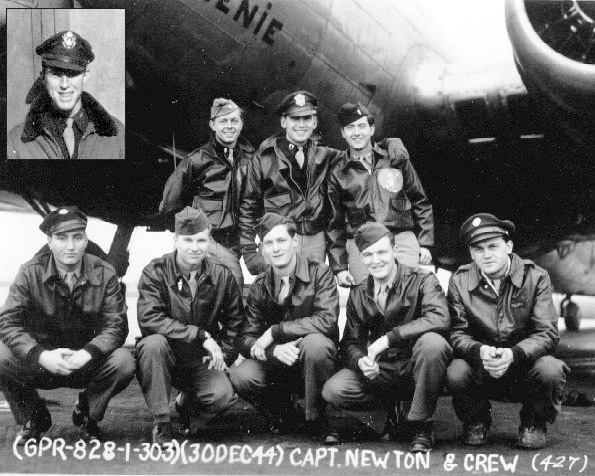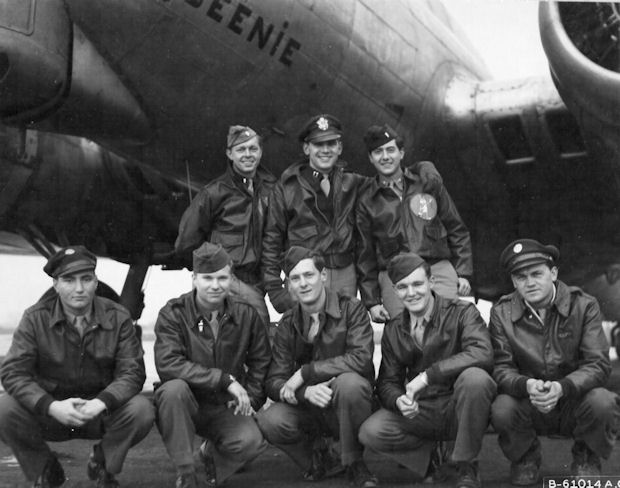 |
427th Newton Crew George C. Newton, Pilot |
Personnel
Mission Reports

GEORGE C. NEWTON CREW - 427th BS
B-17G Queenie #42-97281 GN-Q
(crew assigned 427BS: 17 Aug 1944 - photo: 30 Dec 1944)
(Back L-R) 1Lt Willard L. Lewis (B), Capt George C. Newton (P),
1Lt John I. Jenkins (N)
inset: 2Lt Stonewall Jackson Raley (CP)
(Front L-R)
S/Sgt Samuel S. Hartog (BT),
T/Sgt Byron D. Corn (R),
S/Sgt Lawrence E. Simon (WG),
S/Sgt Leslie E. Karr (TG),
T/Sgt Joseph R. Schneider (E)
(Final crew ranks and grades are indicated.)
Crew Notes:
Flew together as a crew on their first 13 combat missions (#234 - 30 Aug 44 to
#253 - 7 Oct 1944). 1Lt George C. Newton (P) became a Lead Crew Pilot and
was promoted to Captain on 22 December 1944. 2Lt Stonewall Jackson "Red" Raley
(CP), 1Lt John I. Jenkins (N) and 1Lt Willard L. Lewis (B) then became 427th
fill-in crewmen flying with various Pilots, including a few with Lt Newton.
The enlisted crewmen flew most of their additional missions with Lt (Capt)
Newton. All crewmen, except 2Lt Raley, completed their combat tours without injury.
2Lt Stonewall Jackson Raley (CP), photo inset, flew with Lt Newton on 16 of
his 23 combat missions. He had the misfortune to be on the Merseburg mission of
21 Nov 1944 with the 1Lt Peter F. Cureton ill-fated crew (8 KIA & 1 POW). For some inexplicable reason, German civilians murdered four of the crewmen,
including Lt Raley, after they had safely parachuted to the ground. Click here for more information.
Crew Formation and Flight to England:
Captain Newton's Crew was formed in May 1944 at Rapid City Army Air
Base, South Dakota. After completion of training at Rapid City Newton's Crew
was transported to Kearney, Nebraska in some extremely uncomfortable 1890s
vintage rail cars. Mercifully, this was not a terribly long journey. At
Kearney, a factory fresh B-17 was provided to the Newton Crew to fly across
the Atlantic. The first two stops on this trek were Bangor, Maine and
Gander, Newfoundland. While waiting for the weather to improve at Gander,
one of 1Lt O'Leary's Crew painted a rather large mural of a reclining nude in
one of the quarters. This painting was thought to be quite an improvement in
the existing decor by the Americans, but the Canadian military hosts did not
concur and requested the prompt removal of the offending art. Once the skies cleared the
Newton Crew left Gander for Northern Ireland at dusk. The next morning
this crew descended through some clouds and found themselves directly over a
convoy. Pilots and crews had been warned to stay clear of transatlantic
convoys as B17s might be mistaken for enemy aircraft and could be fired upon.
A rather hasty departure was made from the immediate area.
After a long and relatively uneventful journey the Newton Crew landed at Nutt's Corner, Northern Ireland. Once in Northern Ireland the newly arrived airmen were relieved of their aircraft and transported by ferry and rail to a central processing point at Stone, England. During a foggy, early morning crossing of the Irish Sea (Larne, Northern Ireland to Stranraer, Scotland) the ferry was briefly delayed by the unexpected surfacing of a submarine nearby. Fortunately, the submarine was British. From Stone the Newton Crew was sent to Bovingdon, England for orientation training where they were ultimately assigned to the 303rd Bomb Group.
Mission Incidents:
Unknown 1944 date: One of the jobs of the B-17G Bombardier was to load 50
caliber ammunition into the chin turret guns prior to takeoff. Before a
mission 1Lt Willard L. Lewis (B) was doing just that when he inadvertently
unleashed a few rounds. At that very moment Lt Newton (P) happened to be
standing under the chin turret. His hearing returned to normal sometime
later that day.
16 Nov 1944 mission #273 to Weisweiler, Germany: Thirty-one returning aircraft were diverted to RAF Satellite Station, Sleap, England. 359th BS Pilot, 2Lt C.J. Gates, landed the 28th B-17. He overshot the short runway and the right tire blew when braking action was applied. This created an obstruction at the end of the runway. 1Lt George C. Newton's 427th BS B-17G #42-97281 Queenie (GN-Q) was the 30th to land. He landed long due to malfunctioning brakes and failed in a ground loop attempt. The right wing of Newton's B-17 hit the left wing of parked 359th BS B-17 #43-38878 (no name). Queenie came to rest off the hard surface, hub deep in mud. There were no injuries. As this was an RAF base, proper equipment was not available to pull Queenie back to the hard surface through the tracks already made. When last observed by the Newton Crew, British workers were attempting to free their B-17 from the mud using the very laborious method of digging trenches in front of the tires and moving the aircraft forward. Queenie was eventually retrieved from Sleap and returned to service only to crash land in March 1945 near Sandwich, England.

in consultation with his Navigator father John I. Jenkins]
[Researched by 303rdBGA Historian Harry D. Gobrecht]